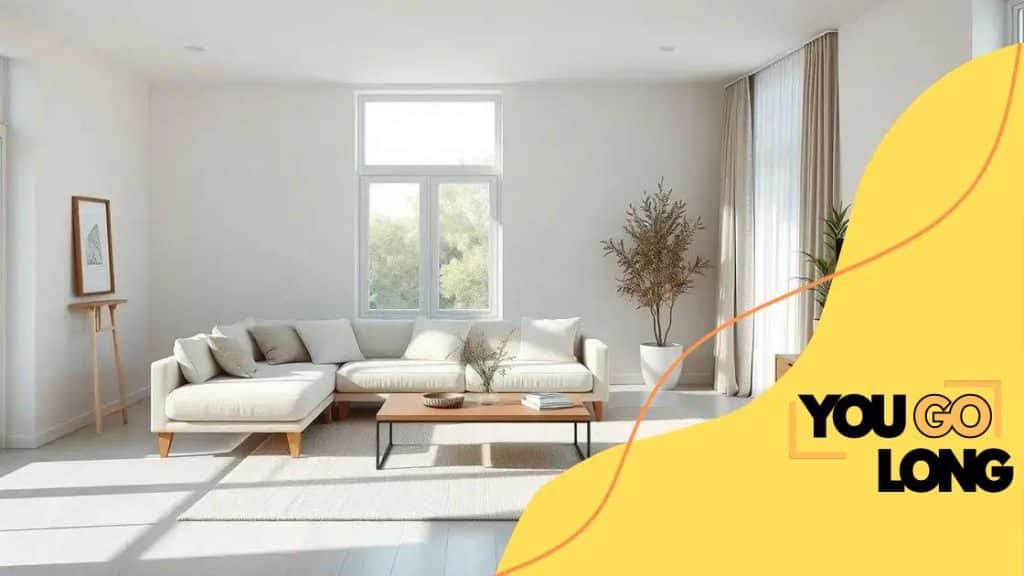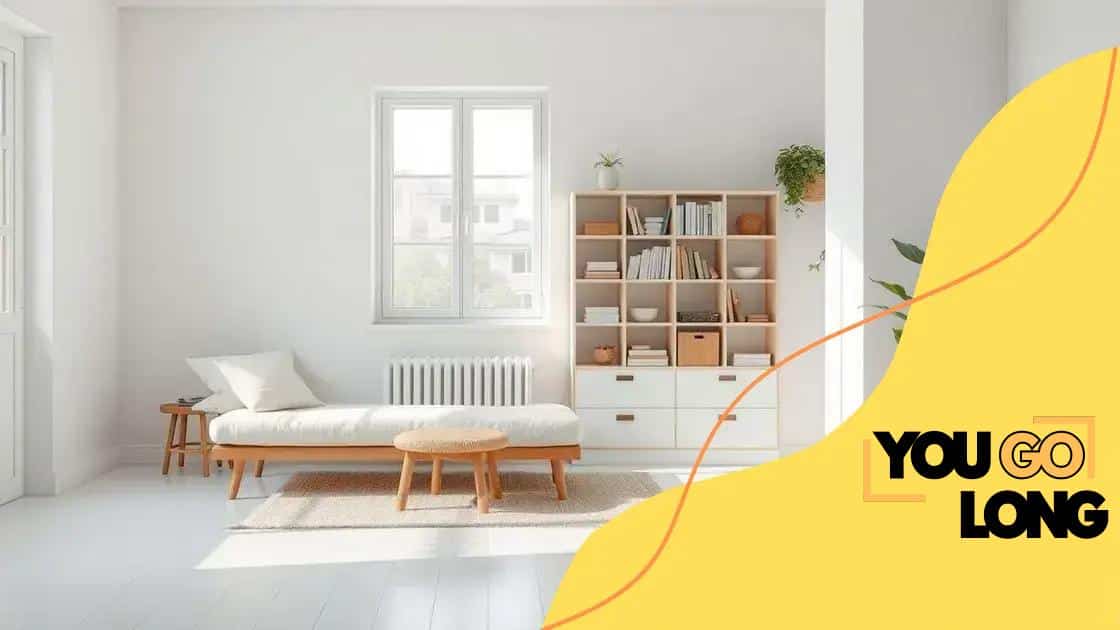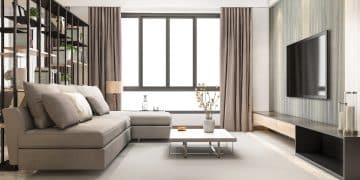The rise of minimalistic decor in modern homes

Advertisement
The rise of minimalistic decor in modern homes emphasizes simplicity and functionality through natural materials, neutral colors, and multifunctional furniture to create a calm and organized living space.
The rise of minimalistic decor in modern homes has captured the imagination of many. Have you ever wondered how simple designs can create such a soothing atmosphere? Let’s explore what minimalism can do for your space.
Understanding minimalism in home decor
Understanding minimalism in home decor can transform your living spaces into peaceful havens. This design style focuses on simplicity, clarity, and functional beauty.
The Essence of Minimalism
At its core, minimalism is about reducing the clutter. Emphasizing open spaces and light can create an inviting atmosphere. Each piece of furniture and decor has a purpose and meaning, creating harmony in the room.
Advertisement
Key Principles of Minimalism
When designing a minimalistic space, keep in mind these essential principles:
- Less is more: Fewer items make for a cleaner look and feel.
- Neutral colors: Soft palettes help to create a calm environment.
- Quality over quantity: Invest in a few high-quality pieces instead of many.
A minimalistic room should invite relaxation and ease. Incorporating natural materials like wood or stone can enhance this atmosphere. Large windows that let in natural light are also essential.
How Minimalism Affects Mood
When we declutter our homes, we often notice an improvement in our mood. Spaces that feature minimalistic decor can reduce anxiety and promote mindfulness. Less visual noise allows for more focus and tranquility.
Advertisement
Adopting a minimalistic approach doesn’t mean sacrificing style. It can be incredibly chic and sophisticated. Carefully selected decor elements can still express your personality without overwhelming the space.
Ultimately, embracing minimalism is about finding joy in simplicity. It’s about creating a lifestyle that prioritizes peace and clarity. This design philosophy encourages you to let go of what you don’t need, making room for what truly matters.
Key elements of minimalistic designs
Key elements of minimalistic designs create spaces that are both functional and aesthetically pleasing. These elements focus on simplicity, elegance, and a sense of calm.
Essential Features of Minimalism
One of the main principles is to use a limited color palette. Neutral shades like white, beige, and gray dominate, making spaces feel open and airy. Natural light is also crucial, enhancing the minimalist vibe by reducing reliance on artificial lighting.
Furniture Choices
Furniture in minimalistic designs is often simple and uncluttered. Look for pieces that are:
- Functional: Each item should serve a purpose.
- Geometric: Clean lines and basic shapes maintain simplicity.
- Versatile: Choose furniture that can adapt to different needs.
Avoid excess ornamentation. Instead, embrace the beauty of functionality. The idea is to create a space where each piece stands out on its own.
Use of Textures and Materials
Incorporating different textures adds depth to minimalism. Consider using materials such as wood, metal, and glass. These can introduce warmth and interest without overwhelming the space.
A minimalistic design thrives on the careful selection of decor items. Choose art pieces or accessories that resonate with your style while keeping the overall look clean. Plants can also enhance minimalism, bringing a touch of nature indoors.
Overall, mastering minimalistic designs is about creating a harmonious space. By focusing on a few key elements, it becomes easier to maintain balance and tranquility throughout your home.
Benefits of adopting minimalism

Adopting minimalism offers several benefits that can significantly improve your quality of life. This lifestyle encourages you to focus on what truly matters, creating a sense of peace and clarity.
Reduced Stress
One major benefit of minimalism is reduced stress. When you declutter your space, you eliminate distractions and create a more calming environment. This makes it easier to relax and enjoy your surroundings.
Enhanced Focus
Minimalism promotes enhanced focus on daily tasks. By minimizing physical clutter, you can clear mental clutter too. This allows you to concentrate better on your work or hobbies without being overwhelmed by your environment.
Financial Savings
Another significant advantage is financial savings. Living a minimalistic lifestyle often means buying less. You can save money by choosing quality over quantity. Here are some ways you can cut costs by adopting minimalism:
- Fewer purchases: Buying only what you need reduces spontaneous expenses.
- Less maintenance: Owning fewer items means less time and money spent on upkeep.
- Quality investments: Spending on durable, high-quality products saves money in the long run.
Minimalism also fosters mindfulness. It encourages you to appreciate the things you have instead of constantly seeking more. By embracing a simpler lifestyle, you can become more attuned to your surroundings and relationships.
Additionally, minimalism can promote sustainability. Choosing less means consuming fewer resources and creating less waste. This approach benefits the environment and encourages a more responsible lifestyle.
Tips for implementing minimalism at home
Implementing minimalism at home starts with making small changes that can lead to a more organized and peaceful environment. The goal is to simplify your space while still enjoying the comfort and style you love.
Start with Decluttering
The first step is to declutter your living space. Go through your belongings and ask yourself what you truly need. Consider these questions as you sort through items:
- Do I use this item regularly?
- Does it bring me joy?
- Is it functional?
Once you’ve decided what to keep, donate or dispose of the rest. Less clutter leads to a more serene atmosphere.
Choose Functional Furniture
When selecting furniture, choose pieces that are both beautiful and functional. Look for items that serve multiple purposes. For instance:
- Storage ottomans: They can be used for seating and storage.
- Expandable tables: Perfect for hosting guests without taking up too much space when not in use.
- Wall-mounted shelves: Great for displaying decor without cluttering surfaces.
By making smart furniture choices, you can enhance the minimalist look of your home.
Adopt a Minimalist Mindset
Embrace the minimalist mindset by focusing on quality rather than quantity. Invest in fewer, high-quality items that you truly need. This approach not only helps you keep your space cleaner but also encourages you to appreciate what you own.
Establish routines to maintain your minimalist space. Set aside time each month to reevaluate your belongings and remove anything unnecessary. This practice can keep clutter from building up.
Additionally, consider your decor choices. Opt for simple and meaningful decor pieces that reflect your personality without overwhelming the space. A few well-placed items are often more impactful than numerous decorations.
Trends in minimalistic home decor
Trends in minimalistic home decor are evolving as more people seek simplicity and functionality in their living spaces. These trends highlight a move towards cleaner lines, more open spaces, and a focus on natural materials.
Focus on Natural Elements
One of the most notable trends is the use of natural materials. Homeowners are increasingly favoring wood, stone, and organic fabrics. These elements bring warmth and texture into minimalistic designs while promoting a connection to nature.
Neutral Color Palettes
Neutral color schemes remain popular in minimalistic decor. Shades like white, beige, and gray create a calm atmosphere. It allows homeowners to build a versatile foundation. Accent colors can be introduced through accessories, but the overall look remains understated.
Functional Furniture Design
Furniture trends also reflect minimalism’s principles. Consumers are looking for functional pieces that serve multiple purposes. Popular options include:
- Foldable tables: Space-saving solutions for smaller homes.
- Storage ottomans: Stylish seating that doubles as storage.
- Multi-functional sofas: Convertible designs for flexibility.
This shift encourages a more efficient use of space, making the home feel less cluttered.
Incorporating Greenery
Plants are becoming a staple in minimalistic decor. They add life to spaces without requiring excessive decoration. Incorporating greenery helps purify the air and brings a refreshing element to any room.
As minimalistic trends continue to grow, focusing on sustainability is gaining importance. Homeowners are conscious of their environmental impact and are choosing eco-friendly materials and practices.
Smart home technology is also making its way into minimalistic designs. Integrated systems can help manage lighting, security, and temperature, creating a seamless and efficient living environment.
In conclusion, adopting minimalism in home decor not only fosters a serene living environment but also encourages a more purposeful lifestyle. By focusing on essential elements, you can reduce clutter and enhance your overall wellbeing. Trends like using natural materials, neutral colors, and multifunctional furniture support this lifestyle, making homes both stylish and functional. Embracing minimalism can lead to financial savings, reduced stress, and a greater appreciation for the space you inhabit.
FAQ – Frequently Asked Questions about Minimalistic Home Decor
What are the main benefits of adopting minimalism in home decor?
Adopting minimalism can reduce clutter, lower stress, and promote a more peaceful living environment.
How can I start implementing minimalism at home?
You can begin by decluttering your space, choosing functional furniture, and focusing on a neutral color palette.
What materials should I use for a minimalistic decor style?
Natural materials like wood, stone, and organic fabrics work well for creating a warm and inviting minimalistic space.
Are there current trends in minimalistic decor I should know about?
Yes, trends include the use of multifunctional furniture, incorporating greenery, and emphasizing sustainable practices.





